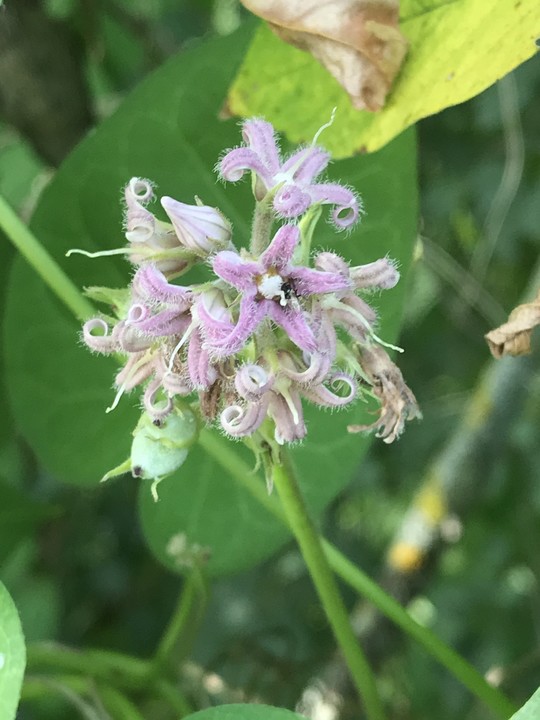|
Having trouble viewing this email? View it as a Web page.
June 1, 2021
June Weed of the Month: Vining Milkweeds and Rough Potato
Christina Basch, Minnesota Department of Agriculture
There are over 2,900 described species in the milkweed family. Minnesota is home to 14 native milkweeds, all of which are herbaceous perennials. In the summer of 2020, a vining milkweed was discovered along the Lake Wobegon Trail by a University of Minnesota Extension Master Naturalist. Though species of non-native vining milkweeds had been documented in Minnesota, this new infestation turned out to be rough potato (Metaplexis japonica).
 Rough potato flowers. Courtesy Bob Dunning, Stearns County
Click here to download the image.
Rough potato is a vining milkweed species from northeastern Asia. Vines are herbaceous and regrow from their roots every year. Flowers are a showy magenta, with five petals that curve along the edges. Flowering occurs from July to September, and hairs are present along the petals and vines. Leaves are opposite, heart shaped, and 3-5 inches long. Vines can grow up to 25 feet long, twine with each other, and climb adjacent vegetation and structures. Rough potato produces a fruit similar to common milkweed fruit pods.
 Rough potato leaves and fruit. Courtesy the Minnesota Department of Agriculture
Click here to download the image.
Rough potato has only been reported once previously in the United States during the 1950s in Ames, Iowa. It is not a commonly sold plant in the United States, and it’s uncertain how it arrived in Minnesota. Missouri Botanical Gardens state that rough potato does best in USDA Zones 6b-8, yet it was discovered thriving in Holdingford, Minn. (Zone 3b). While a formal risk assessment has not been conducted yet, the vine is similar to another vining milkweed, black swallow-wort, which is a Prohibited Eradicate Noxious Weed.
 Rough potato smothering fence and trees. Courtesy the Minnesota Department of Agriculture
Click here to download the image.
Black and pale swallow-worts are toxic to monarch butterflies and are believed to have contributed to the population decline in the eastern United States. It is unknown what effects established rough potato populations will have on already declining monarch populations. Given the observed infestation severity, we recommend not purchasing and planting this species to allow time for a risk assessment to be conducted. If you suspect you have found rough potato, note the exact location with the address or GPS coordinates. If it is possible, take digital photos of the flower, vine, leaves, and fruit and email them to the Minnesota Department of Agriculture (MDA) for identification.
Infestations can be reported to one of two places:
- The MDA by email at arrest.the.pest@state.mn.us or voicemail at 1-888-545-6684
- Directly to EDDMapS through the EDDMapS app on a smartphone or tablet, or at EDDMapS.org
MEDIA: For more information on Weed of the Month, contact Allen Sommerfeld, MDA Communications, at allen.sommerfeld@state.mn.us or 651-201-6185
|